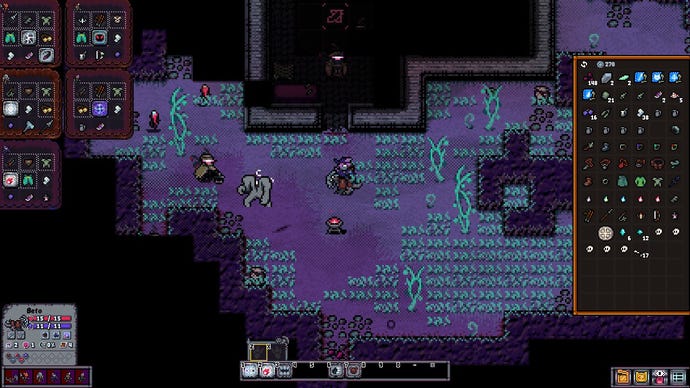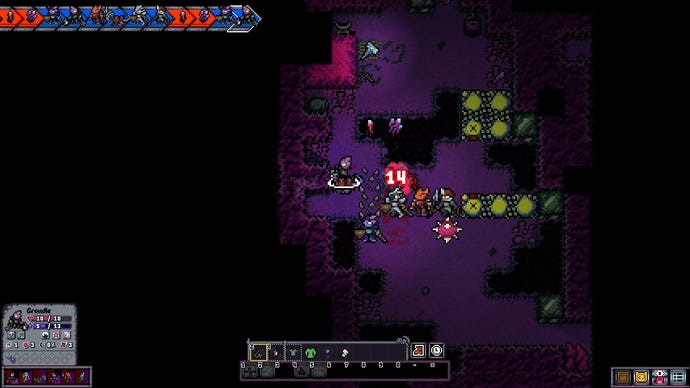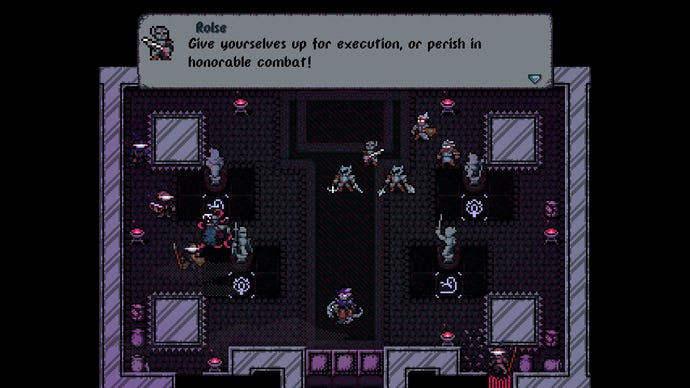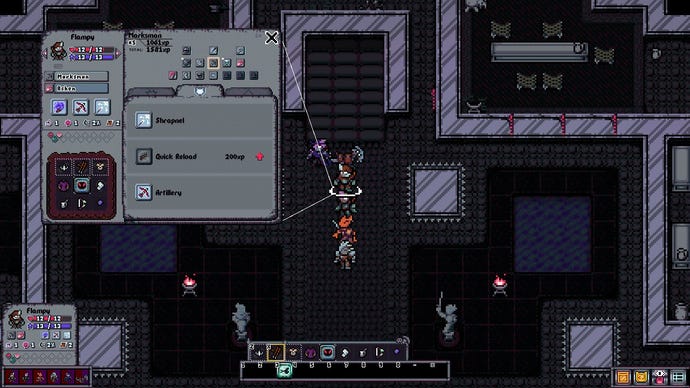Products You May Like
I disliked turn-based RPG Kingsvein at first. Quite a bit, in fact. An earlier version of this review would have been a very negative on, filled mostly with complaints and annoyances about opaque and frustrating systems, most of which I’ve since got over as the intent behind its design has become more clear.
It could definitely explain some things better, and its inscrutably tiny graphics remain a minor nuisance. But it’s grown on me a lot, and though it may not be quite the kind of turn-based RPG I get on with best, it’s an enjoyable one with a refreshing lack of bloat and timewasting, and with a class and combat system that will be pure catnip to a particular kind of player.
Plot-wise, there’s not much to keep track of. There’s trouble in the city of Kingsvein, so a wisp stalker named Chorble is sent to kill the wisps (floaty ghosty tentacly things that like to possess and revive bodies) behind it, and is soon accompanied by their friends Beto, Flampy, and Grondle. You uh, might give them different names.




There’s a friendly warrior from afar and some utility NPCs to pitch in, but very limited dialogue, which perhaps limits the plot, but also limits time wasted listening to NPCs fill space for the hell of it. A few semi-secret bits add detail to the world, but mostly this is about finding the next visible target and running up to them to trigger a fight. Or leveling up your dudes in random battles if they’re falling short.
By far the most interesting element is the class system, which was initially one of my complaints, as everyone starts out more or less the same, and most of the early options are very limited. Each character has a main class, with experience points for winning battles letting you buy special attacks, abilities from that class’s unique list, or unlock passive perks. A third panel grants a special star for every few hundred points earned in a class (total points spent on other abilities still count towards stars), which can be exchanged for permanent buffs like more health, hitting harder with electrical attacks, and so on.
You also get a secondary class for free, which lets you use the abilities you’ve unlocked in both classes at once. This is significant because gaining XP in a class also unlocks more classes, which you can freely switch around out of combat. But you can only use the abilities of your two active classes (a rare item lets one character hold three or four). In practice this means a lot of leveling sideways. Sticking with one class is viable thanks to those star rewards, but rather than having numbered levels, everyone’s defined by whatever abilities you’ve had them gather. I have an orange spear guy, but you might have him down as orange fire archer, or invisible orange flail wizard.

There are lots more details than that, and its initially opaque class and skill system becomes its strength once you figure out how it works. You can trial and error to some extent too, as unlocking a few skills you never use doesn’t render anyone underleveled, and a few side battles will fix that anyway.
This was a source of frustration early on. Several early skills are borderline useless, with most magic attacks having very limited range and being blocked by allies, exacerbated by some unclear descriptions. An archery attack that does 80% damage but has the perk, “Two shots split off backwards”, might turn out to be a game changer, but is so niche it’s just as likely to sit untouched in your pocket. In particular, many attacks are “delayed”, and only kick in at the end of the enemy’s turn, meaning they’ll nearly always just move out of the way unless you immobilise them in advance with someone else’s powers. Chances are, you won’t have much access to these powers yet. Delayed healing power, meanwhile, might target a square rather than a character, so your idiot healers fire them at enemies instead.
If you’re the kind of player who likes setting up obscure trick shots utilising multiple classes and characters and layered status effects, Kingsvein’s combat will be catnip. You might even find it too easy once you learn how to floop the pig.
Me though, I don’t mind drinking from the dweeb cup, and Kingsvein won’t hold it against you either. There’s as much exploration of caves and ruined buildings as combat. This turns up tonnes of loot with a hint of Ultima 6-7 as you meticulously pick things off the floor and put them in your shared bag. Equipment can intensify a character’s strengths or round them out, or just give a healer a crossbow option because why not. Weapons work a tiny bit like Wildermyth – swords do more damage, and spears hit two squares in a row (and one ability makes them heal friendlies), but flails can attack diagonally and add more power to the Marshall class’s “strike” action, that instructs every friendly who can bash the targeted enemy to do so.

There’s basic crafting too, which really comes down to clicking spare weapons into ore or vice versa at a 1:1 return rather than any faffing about with “recipes”, and then adding a spike or magical lightning blob to a sword or a protective thing to your armour. There’s a minor but pleasant satisfaction to doing this, and it’s only an occasional thing rather than a constant sisyphean cycle of adding +1 to everything. Neither crafting or combat are the number crunching sort of game I’d feared, but the tiny graphics make it difficult to tell what a given enemy is capable of, and what little squiggly symbol something is going to upgrade. Bodies take up space on the battlefield, making some fights a real headache until you’ve got both a team and the personal experience needed to maneouvre and position effectively.
But I did learn those things, despite spurning most classes and only delving knee-deep in its possibilities after finding some mostly effective ones that I enjoyed. Those early frustrations gave way to satisfaction at scraping through a close call, and feeling like I’d won a fight through applying the right skills and plans, and making progress because I’d learned to judge my team’s capabilities rather than just make a number go up enough. That’s a great spot for any RPG to be in, and if you’re less interested in complex or hefty narratives than some chunky tactical combat and tinkering with characters as toolboxes, Kingsvein could be a slightly rough gem.
This review was based on a retail build of the game provided by the developer.
